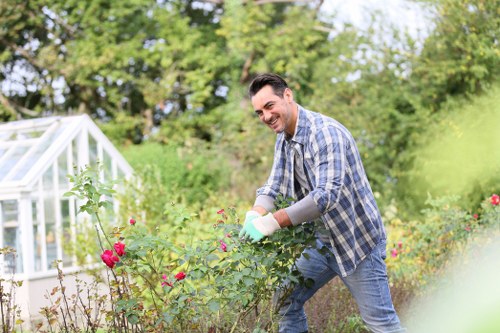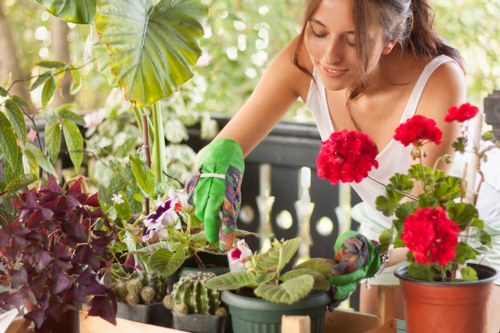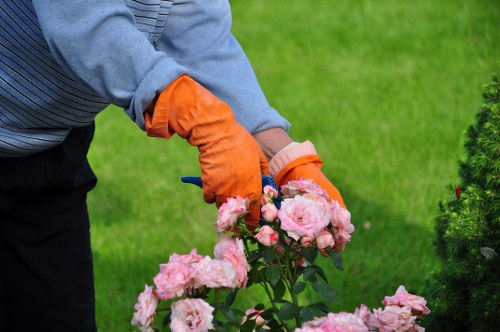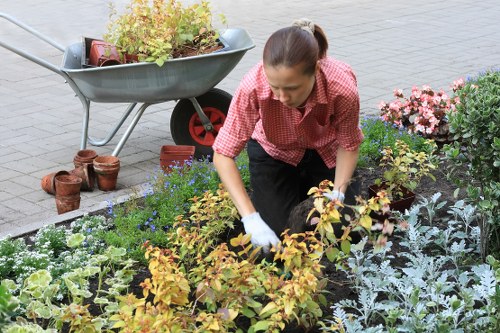Garden Clearance in Lawn Mowing: Essential Steps for a Pristine Lawn

Maintaining a beautiful lawn requires more than just regular mowing. Garden clearance plays a pivotal role in ensuring your lawn remains healthy, vibrant, and free from unwanted debris. By integrating garden clearance with lawn mowing, homeowners can achieve a well-maintained outdoor space that enhances the aesthetic appeal of their property.
Over time, gardens can accumulate leaves, branches, and other organic matter that hinder the growth of grass and other desirable plants. Effective clearance not only promotes a healthier lawn but also prevents potential issues such as pest infestations and weed growth. Understanding the importance of garden clearance can help you maintain a lush and inviting garden throughout the year.
In this comprehensive guide, we will explore the various aspects of garden clearance in lawn mowing, including the best practices, essential tools, and the benefits of professional services versus DIY methods. Whether you're a seasoned gardener or a novice, this article will provide valuable insights to help you achieve the lawn of your dreams.

The Importance of Garden Clearance in Lawn Mowing
Garden clearance is a critical component of lawn maintenance that involves removing unwanted vegetation, debris, and other materials from your garden and lawn areas. This process ensures that your grass receives adequate sunlight, water, and nutrients, which are essential for its growth and vitality.
Without regular clearance, organic matter can accumulate, creating a thick layer that suffocates the grass and inhibits its ability to photosynthesize. This leads to weakened grass that is more susceptible to diseases, pests, and environmental stressors. Additionally, debris such as fallen branches and dead plants can create hiding spots for pests, increasing the likelihood of infestations.
Moreover, garden clearance enhances the overall appearance of your yard, making it look more organized and inviting. A well-maintained garden is not only pleasing to the eye but also increases the value of your property. By prioritizing garden clearance alongside lawn mowing, you can ensure a healthier and more attractive outdoor space.

When to Clear Your Garden
Seasonal Considerations
Timing is crucial when it comes to garden clearance. Different seasons bring varying challenges and tasks that need to be addressed to maintain a healthy lawn. Understanding these seasonal factors can help you plan your garden clearance activities more effectively.
Spring Clearance
As the weather warms up, spring is an ideal time to start clearing your garden after the winter months. Remove any dead plant material, fallen leaves, and debris that have accumulated. This helps prepare the ground for new growth and ensures that your lawn can benefit from the increased sunlight and rainfall.
Summer Maintenance
During the summer, regular clearance is necessary to keep your garden and lawn in top condition. Remove weeds, trim overgrown plants, and ensure that your grass is not being overshadowed by larger vegetation. This will help maintain optimal growth conditions and prevent your lawn from becoming overrun.

Post-Harvest Clearance
After harvesting, it's important to clear away any plant remnants and debris. This not only keeps your garden tidy but also reduces the risk of pests and diseases that can thrive in leftover organic matter.
Pre-Winter Preparation
Before the onset of winter, perform a final clearance to remove any lingering debris that could cause issues during the colder months. This includes clearing fallen leaves, dead branches, and any other materials that may obstruct the growth of the lawn in the spring.

Tools and Equipment for Garden Clearance
Having the right tools and equipment is essential for effective garden clearance. Investing in quality tools not only makes the task easier but also ensures that you achieve the best possible results.
Basic Tools
- Lawn Mower: A reliable lawn mower is fundamental for regular mowing and maintaining the height of your grass.
- Rake: A sturdy rake helps in gathering leaves, grass clippings, and other debris efficiently.
- Pruners and Shears: For trimming overgrown bushes and shrubs, pruners and shears are indispensable.
Advanced Equipment
- Leaf Blower: Speeds up the process of clearing large areas by blowing away leaves and light debris.
- Brush Cutter: Useful for tackling thicker vegetation and weeds that regular lawn mowers can't handle.
- Compost Bin: Allows you to recycle organic waste into nutrient-rich compost for your garden.
Step-by-Step Guide to Garden Clearance
Embarking on garden clearance can seem daunting, but breaking it down into manageable steps makes the process less overwhelming. Follow this step-by-step guide to ensure a thorough and efficient clearance.
1. Assess Your Garden
Begin by evaluating the current state of your garden. Identify areas that require immediate attention, such as overgrown sections, areas with excessive debris, and spots prone to weed growth.
2. Gather Your Tools
Ensure you have all the necessary tools and equipment before starting. This includes a lawn mower, rake, pruners, leaf blower, and any other tools specific to your garden's needs.
3. Remove Large Debris
Start by clearing away large debris such as fallen branches, rocks, and any other substantial materials. This makes the subsequent steps easier and prevents damage to your tools.
4. Mow the Lawn
Use your lawn mower to cut the grass to an appropriate height. Regular mowing promotes healthy growth and prevents the grass from becoming too tall, which can lead to disease and pest problems.
5. Rake and Collect Debris
Rake up leaves, grass clippings, and other small debris. Collect them in a designated area for composting or disposal. This step helps maintain a clean and tidy garden.
6. Trim and Prune
Trim overgrown bushes, shrubs, and hedges to encourage healthy growth. Pruning also enhances the overall appearance of your garden, giving it a well-maintained look.
7. Weed Control
Identify and remove weeds from your garden and lawn areas. Weeds compete with your grass for nutrients and water, so keeping them in check is essential for a healthy lawn.
8. Final Cleanup
Perform a final cleanup to ensure no debris or tools are left behind. Check all areas of your garden to confirm that the clearance process is complete.
Safety Tips for Garden Clearance
While garden clearance is beneficial, it's important to prioritize safety to prevent accidents and injuries. Follow these safety tips to ensure a secure working environment.
Wear Protective Gear
Always wear appropriate protective clothing, including gloves, safety goggles, and sturdy footwear. This protects you from potential injuries caused by sharp tools, debris, and harmful substances.
Maintain Your Tools
Regularly inspect and maintain your tools to ensure they are in good working condition. Sharp, well-maintained tools are safer and more effective.
Use Tools Properly
Familiarize yourself with the correct operation of each tool. Improper use can lead to accidents and damage to your garden.
Benefits of Professional Garden Clearance Services
While DIY garden clearance can be effective, hiring professional services offers numerous advantages that can save you time and ensure optimal results.
Expertise and Experience
Professional garden clearance teams possess the knowledge and experience to handle various garden challenges efficiently. They can identify and address issues that may not be apparent to the untrained eye.
Time-Saving
Garden clearance can be time-consuming, especially for larger gardens. Professionals can complete the task more quickly, allowing you to focus on other important aspects of your life.
Proper Disposal
Professionals ensure that all cleared debris is disposed of properly, adhering to local regulations and environmental guidelines. This promotes eco-friendly practices and maintains the cleanliness of your property.
DIY vs Professional Garden Clearance
Choosing between DIY and professional garden clearance depends on various factors, including the size of your garden, your budget, and your personal preferences.
Advantages of DIY
- Cost-effective as you eliminate service fees.
- Flexible scheduling to fit your availability.
- Satisfaction of completing the task yourself.
Advantages of Professional Services
- Access to specialized tools and equipment.
- Guaranteed quality and thoroughness.
- Expert advice for ongoing garden maintenance.
Which Option is Right for You?
Consider your garden's specific needs, your available time, and your willingness to invest in tools and supplies. For extensive garden clearance or if you prefer a hassle-free experience, professional services may be the better choice.
Eco-Friendly Garden Clearance Practices
Adopting eco-friendly practices in garden clearance benefits both your lawn and the environment. Here are some sustainable methods to incorporate into your garden maintenance routine.
Composting
Instead of disposing of organic waste, compost it to create rich, nutrient-dense soil for your garden. Composting reduces landfill waste and improves soil health.
Mulching
Use mulching techniques to cover the soil, retain moisture, and suppress weed growth. Organic mulches, such as wood chips and straw, are environmentally friendly options.
Natural Pest Control
Implement natural pest control methods to reduce the need for chemical fertilizers and pesticides. Encourage beneficial insects and use organic treatments to maintain a healthy garden ecosystem.
Maintaining Your Garden After Clearance
Once you've completed garden clearance, ongoing maintenance is essential to preserve the results and ensure your lawn remains in excellent condition.
Regular Mowing
Mow your lawn regularly to maintain an even height and promote healthy grass growth. Adjust the mowing frequency based on the growth rate of your grass.
Adequate Watering
Ensure your lawn receives sufficient water, especially during dry periods. Proper watering supports strong root development and overall plant health.
Fertilization
Apply appropriate fertilizers to provide essential nutrients that support vigorous growth and resilience against pests and diseases.
Ongoing Weed Control
Stay vigilant in removing weeds as they appear. Prompt weed control prevents them from establishing and competing with your grass for resources.
Common Mistakes to Avoid During Garden Clearance
Even with the best intentions, certain mistakes can undermine your garden clearance efforts. Being aware of these pitfalls helps you achieve better results.
Over-Mowing
Mowing your grass too short can stress the plants, making them more vulnerable to diseases and pests. Aim to remove no more than one-third of the grass height in a single mowing session.
Ignoring Safety Precautions
Failing to wear protective gear or improperly handling tools can lead to accidents. Always prioritize safety to prevent injuries.
Neglecting Regular Maintenance
Garden clearance is not a one-time task. Regular maintenance is necessary to keep your lawn and garden in optimal condition and prevent the buildup of debris.
Avoiding DIY Overload
Pushing yourself to handle all aspects of garden clearance without the necessary tools or expertise can lead to frustration and subpar results. Know your limits and consider seeking professional help when needed.
Conclusion
Integrating garden clearance with lawn mowing is essential for maintaining a healthy, attractive, and sustainable outdoor space. By following the best practices outlined in this guide, you can ensure that your garden remains vibrant and your lawn pristine throughout the year.
Whether you choose to undertake garden clearance yourself or hire professional services, the key is to stay consistent and attentive to your garden's needs. Regular maintenance, combined with eco-friendly practices, will not only enhance the beauty of your property but also contribute to a healthier environment.
Ready to transform your garden into a lush paradise? Contact us today to book your garden clearance and lawn mowing services tailored to your specific needs.
Don't wait! Book your service now and take the first step towards a stunning and well-maintained garden.